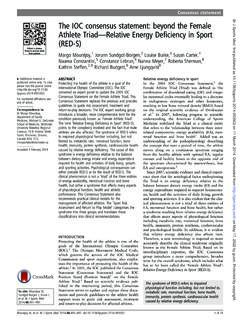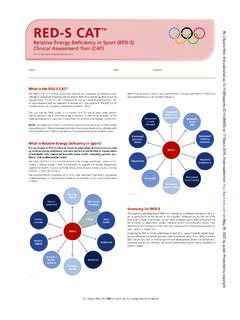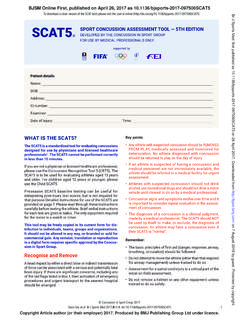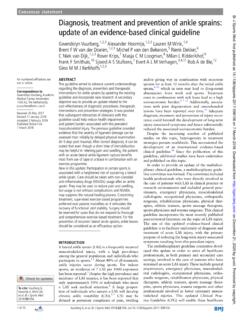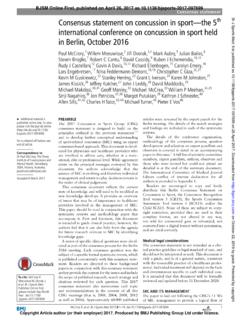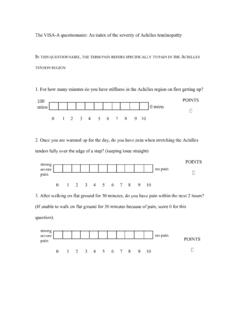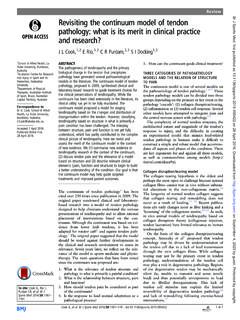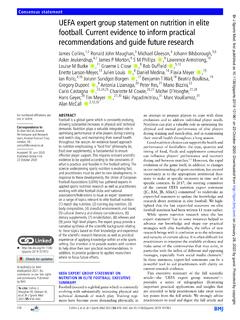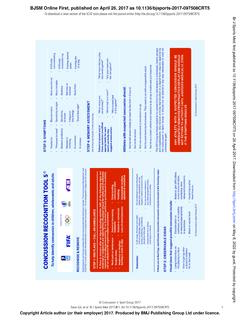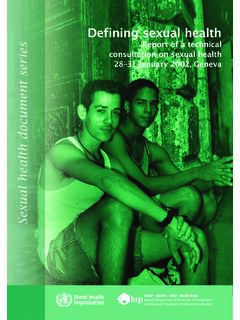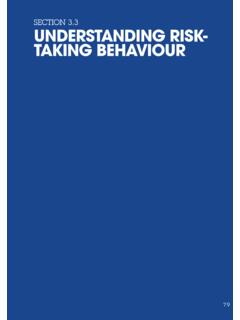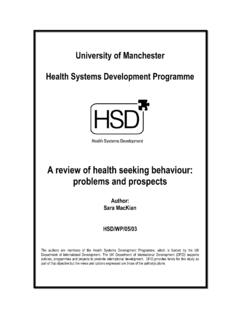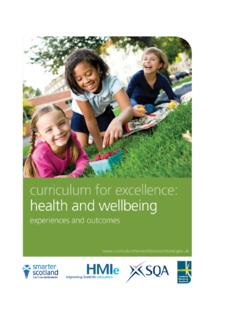Transcription of World Health Organization 2020 guidelines on physical ...
1 1451 Bull FC, et al. Br J Sports Med 2020;54:1451 1462. Health Organization 2020 guidelines on physical activity and sedentary behaviourFiona C Bull ,1,2 Salih S Al- Ansari,3 Stuart Biddle,4 Katja Borodulin,5,6 Matthew P Buman ,7 Greet Cardon,8 Catherine Carty,9,10 Jean- Philippe Chaput ,11 Sebastien Chastin ,12 Roger Chou,13 Paddy C Dempsey,14,15 Loretta DiPietro,16 Ulf Ekelund ,17,18 Joseph Firth,19,20 Christine M Friedenreich,21 Leandro Garcia,22 Muthoni Gichu,23 Russell Jago ,24 Peter T Katzmarzyk,25 Estelle Lambert ,26 Michael Leitzmann,27 Karen Milton ,28 Francisco B Ortega,29 Chathuranga Ranasinghe,30 Emmanuel Stamatakis ,31 Anne Tiedemann,32 Richard P Troiano ,33 Hidde P van der Ploeg,34,35 Vicky Wari,36 Juana F Willumsen1 GuidelinesTo cite: Bull FC, Al- Ansari SS, Biddle S, et al. Br J Sports Med 2020;54:1451 numbered affiliations see end of toProfessor Fiona C Bull, physical activity Unit, Department of Health Promotion, World Health Organization , Geneva, GE, Switzerland; bullf@ who.
2 IntAccepted 7 September 2020 Published Online First 1 December 2020 Author(s) (or their employer(s)) 2020. Re- use permitted under CC BY. Published by To describe new WHO 2020 guidelines on physical activity and sedentary The guidelines were developed in accordance with WHO protocols. An expert Guideline Development Group reviewed evidence to assess associations between physical activity and sedentary behaviour for an agreed set of Health outcomes and population groups. The assessment used and systematically updated recent relevant systematic reviews; new primary reviews addressed additional Health outcomes or The new guidelines address children, adolescents, adults, older adults and include new specific recommendations for pregnant and postpartum women and people living with chronic conditions or disability. All adults should undertake 150 300 min of moderate- intensity, or 75 150 min of vigorous- intensity physical activity , or some equivalent combination of moderate- intensity and vigorous- intensity aerobic physical activity , per week.
3 Among children and adolescents, an average of 60 min/day of moderate- to- vigorous intensity aerobic physical activity across the week provides Health benefits. The guidelines recommend regular muscle- strengthening activity for all age groups. Additionally, reducing sedentary behaviours is recommended across all age groups and abilities, although evidence was insufficient to quantify a sedentary behaviour These 2020 WHO guidelines update previous WHO recommendations released in 2010. They reaffirm messages that some physical activity is better than none, that more physical activity is better for optimal Health outcomes and provide a new recommendation on reducing sedentary behaviours . These guidelines highlight the importance of regularly undertaking both aerobic and muscle strengthening activities and for the first time, there are specific recommendations for specific populations including for pregnant and postpartum women and people living with chronic conditions or disability.
4 These guidelines should be used to inform national Health policies aligned with the WHO Global Action Plan on physical activity 2018 2030 and to strengthen surveillance systems that track progress towards national and global 2018, the World Health Assembly (WHA) approved a new Global Action Plan on physical activity (GAPPA) 2018 20301 and adopted a new voluntary global target to reduce global levels of physical inactivity in adults and adolescents by 15% by 2030. As part of the WHA Resolution ( ), Member States requested that WHO update the 2010 Global Recommendations on physical activity for and national guidelines on physical activity are a central component of a comprehen-sive and coherent governance and policy frame-work for public Health action. WHO recommends all countries establish national guidelines and set physical activity targets.
5 To help support popula-tions to achieve the targets and maintain healthy levels of physical activity , all countries are advised to develop and implement appropriate national and subnational policies and programmes to enable people of all ages and abilities to be physically active and improve that the most recent global estimates show that one in four ( ) adults3 and more than three- quarters (81%) of adolescents4 do not meet the recommendations for aerobic exercise, as outlined in the 2010 Global Recommendations on physical activity for Health ,2 there is an urgent need to increase priority and investment directed towards services to promote physical activity both within Health and other key sectors. These data also reveal no overall improvement in global levels of participation over the last two decades and substan-tial gender 4 Furthermore, national data consistently show inequalities in participation by age, gender, disability, pregnancy, socioeconomic status and geography,1 amplifying the need to inten-sify investment in physical paper reports on the development of new WHO guidelines on physical activity and sedentary These guidelines provide evidence- based public Health recommendations concerning the amount (frequency, intensity, duration) and types of physical activity that offer significant Health on January 14, 2022 by guest.
6 Protected by J Sports Med: first published as on 25 November 2020. Downloaded from 1452 Bull FC, et al. Br J Sports Med 2020;54:1451 1462. and mitigate Health risks (for definitions see table 1). These guidelines have been developed for children, adolescents, adults, older adults and, for the first time, include specific recom-mendations on physical activity for pregnant and postpartum women and people living with chronic conditions or disability. In addition, for the first time, these WHO guidelines address the Health impact of sedentary behaviour. The new WHO guidelines update previous WHO recommendations on physical activity for Health released in 20102 with the most recent advances in the evidence base for these behaviours and associated selected Health consequences. These new guidelines , together with the guidelines on physical activity , Sedentary Behaviour and Sleep for Children Under 5 Years of Age,6 provide evidence- updated recommendations for physical activity and sedentary behaviour across the life primary audiences and users of these guidelines are policy makers in ministries of Health , education, sport, transport, envi-ronment, social or family welfare and related sectors, working in high- income as well as low- income and middle- income coun-tries (LMICs), who formulate country- specific guidelines and who develop national or subnational plans and programmes to increase physical activity and reduce sedentary behaviours across the life course.
7 Additional key users of these guidelines include researchers and those working in Health services providing advice and guidance (such as community Health workers, primary, secondary or tertiary nurses or doctors), allied Health Table 1 Glossary of termsTermDefinitionAerobic physical activityActivity in which the body s large muscles move in a rhythmic manner for a sustained period of time. Aerobic activity also called endurance activity improves cardiorespiratory fitness. Examples include walking, running, swimming and trainingStatic and dynamic exercises that are designed to improve an individual s ability to withstand challenges from postural sway or destabilising stimuli caused by self- motion, the environment or other strengthening activityPhysical activity primarily designed to increase the strength of specific sites in bones that make up the skeletal system. Bone- strengthening activities produce an impact or tension force on the bones that promotes bone growth and strength.
8 Examples include any type of jumps, running and lifting the International Classification of Functioning, Disability and Health , an umbrella term for impairments, activity limitations and participation restrictions, denoting the negative aspects of the interaction between an individual (with a Health condition) and that individual s contextual factors (environmental and personal factors).Domains of physical activityPhysical activities can be undertaken in various domains, including one of more of the following: leisure, occupation, education, home and/or domain physical activityPhysical activity undertaken in the home for domestic duties (such as cleaning, caring for children, gardening, etc).Leisure- domain physical activityPhysical activity performed by an individual that is not required as an essential activity of daily living and is performed at the discretion of the individual. Examples include sports participation, exercise conditioning or training and recreational activities such as going for a walk, dancing and intensity physical activity (LPA)On an absolute scale, light intensity refers to physical activity that is performed between and 3 METs.
9 On a scale relative to an individual s personal capacity, light- intensity physical activity is usually a 2 4 on a rating scale of perceived exertion scale of 0 10. Examples include slow walking, bathing or other incidental activities that do not result in a substantial increase in heart rate or breathing equivalent of task (MET)The metabolic equivalent of task, or simply metabolic equivalent, is a physiological measure expressing the intensity of physical activities. One MET is the energy equivalent expended by an individual while seated at rest, usually expressed as mLO2/ intensity physical activity (MPA)On an absolute scale, moderate- intensity refers to the physical activity that is performed between 3 and <6 times the intensity of rest (METs). On a scale relative to an individual s personal capacity, MPA is usually a 5 or 6 on a rating scale of perceived exertion scale of 0 to- vigorous intensity physical activity (MVPA)On an absolute scale, MVPA refers to the physical activity that is performed at >3 METs (ie, >3 times the intensity of rest).
10 On a scale relative to an individual s personal capacity, MPA is usually a 5 or above on a scale of 0 physical activityMulticomponent physical activity are activities that can be done at home or in a structured group or class setting and combine all types of exercise (aerobic, muscle strengthening and balance training) into a session, and this has been shown to be effective. An example of a multicomponent physical activity programme could include walking (aerobic activity ), lifting weights (muscle strengthening) and could incorporate balance training. Examples of balance training can include walking backwards or sideways or standing on one foot while doing an upper body muscle- strengthening activity , such as bicep curls. Dancing also combines aerobic and balance domain physical activitySee work domain physical activity (PA)Any bodily movement produced by skeletal muscles that requires energy inactivityAn insufficient physical activity level to meet present physical activity screen timeTime spent watching screens (television (TV), computer, mobile devices) for purposes other than those related to school or screen timeTime spent watching screen- based entertainment while sedentary, either sitting, reclining or lying.
